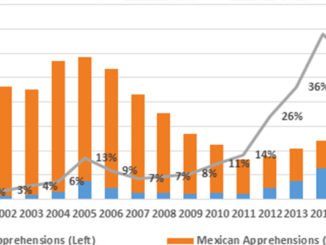
The population of Mexican-born immigrants dropped by more than 300,000 between 2016 and 2017.
New Census figures show the number of Mexican immigrants living in the United States dropped more last year than at any point in the past decade, a plunge that came as the Trump administration took power and made the deportation of unauthorized immigrants a top priority.
The number of U.S. residents — legal and undocumented — born in Mexico has dropped slowly since a peak of 11.7 million before the Great Recession, to 11.3 million in 2017, but the decline of 300,000 between 2016 and 2017 is rare.
The sudden plunge seems to be an acceleration of a long-term trend of native Mexicans returning to their homeland. The results have been tough for Mexico: Among its challenges are schools jammed with English-speaking, often American-born children brought by parents who either were deported, feared deportation or saw more opportunity and less hostility south of the border.
“It could be new opportunity or that the U.S. has made them feel less welcome. I suspect it’s both,” said Andrew Selee, president of the nonpartisan Migration Policy Institute, a think tank based in Washington, D.C.
The last time there was a drop of this magnitude in the Mexican-born U.S. population was between 2007 and 2008, when the Great Recession started and the federal government began cracking down on illegal immigration using the Secure Communities program. That year, the number of Mexican immigrants living in the United States dropped by about 326,000.
Last year, border states and those dependent on immigrant farm labor took the biggest hits in the loss of Mexicans: California lost more than 137,000 Mexican immigrants, and Texas lost more than 55,000. Other states losing more than 10,000 Mexican immigrants were Florida, Georgia, New York and Washington state.
Jessica Vaughan, director of policy studies at the Center of Immigration Studies, which favors lower levels of immigration, said it’s hard to tell what caused the decline. “If it is due to increased enforcement deterring some people from coming here illegally, that could be beneficial. If it prevents them from undertaking a dangerous journey that could cost them their life savings and result in their being harmed or even killed, that is a good thing.”
| Large Drop in Mexican Immigrant Population The population of Mexican-born immigrants dropped by more than 300,000 between 2016 and 2017, the largest drop in a decade. |
|
| Year | One-year change in Mexican immigrant population |
| 2011 | – 38,484 |
| 2012 | – 109,245 |
| 2013 | 21,603 |
| 2014 | 129,512 |
| 2015 | -71,191 |
| 2016 | -69,618 |
| 2017 | -303,767 |
| States with largest drops in Mexican immigrant population, 2016-2017 | ||
| State | One-year change in Mexican immigrant population |
Percentage change |
| California | – 137,352 | -3% |
| Texas | – 55,232 | -2% |
| New York | -27,196 | -11% |
| Washington | -12,711 | -5% |
| Georgia | -12,303 | -5% |
| Florida | -12,109 | -4% |
Sources: U.S. Census American Community Survey and Stateline analysis
Many farmworkers in upstate New York, especially single men, left after the 2016 presidential election raised tension, recalled Luis Jimenez, a dairy farmworker from Mexico who volunteers with the “Alianza Agricola” (Spanish for the Agricultural Alliance), a group of farmworkers advocating for more immigrant rights in New York.
“Some people went back rather than wait to be arrested and deported,” Jimenez said. “Those of us with wives and children mostly decided to stay. It’s a hard choice. It’s dangerous either way. If you go back there’s crime and kidnappings and the schools are not as good, so for now we’re staying for our children’s sake.”
The Mexican government, which interviews returning citizens at the border, has not seen evidence that 300,000 people moved back between 2016 and 2017, said Carlos Hernandez, a statistical technician at the Colegio de la Frontera Norte in Tijuana, Mexico. It’s possible that, because of backlogs in U.S. immigration courts, some have been arrested but not yet deported, he said. “[If] thousands of migrants are detained, but they have not been deported, that could explain the reduction,” Hernandez said.
Nationally, evidence shows that children of immigrants have faced growing hostility in U.S. schools, and that may be driving some parents to move with their children to Mexico even if they’re not forced to do so by deportation or job loss in today’s immigration crackdowns, said Patricia Gándara, the co-director of the Civil Rights Project at UCLA and a professor at the university who studies education.
In a study to be published soon, Gándara and the Civil Rights Project surveyed schools in a dozen states and found the most hostility to immigrant children in the South. Southern states passed a wave of anti-immigration bills in the early 2010s that caused some Hispanic communities to pack up and leave.
“Our researcher heard literally thousands of stories about children crying in school or just not showing up,” Gándara said. “They may be afraid to leave home, thinking their parents could be taken away.”
Tens of thousands of American-born children are enrolling every year in Mexican public schools, Gándara said. And Selee said the number of American children living in Mexico likely has reached more than half a million.
“These are our children,” Gándara said. “They grew up here or were born here, and now they end up in Mexico, a place they may never have seen before. It might be voluntary or involuntary — there could be one deportation but the entire family follows because that’s their livelihood.”
Arrests and deportations of unauthorized immigrants have increased under the Trump administration but are still down from the peak of crackdowns under the Obama administration, in part because of local sanctuary policies that have held down immigration arrests.
The Trump administration has reversed some Obama-era protections for those without criminal convictions and conducted high-profile raids and arrests intended to sow fear even in sanctuary cities.
At the same time, Mexico has boosted wages and agreed to let unions negotiate for workers in a bid to lure back former residents.
Western states such as California, a “sanctuary state,” have broken new ground in protecting the undocumented as much as possible. But many immigrants thought they were targeted for extra harassment as “payback” for those policies through targeted raids and arrests, according to a working paper for the UCLA study.
Western farmers have long depended on immigrant labor, much of it from Mexico, said Cory Lunde, a director at the Western Growers Association, which represents farms in California, Arizona, Colorado and New Mexico. In recent years farmers have seen their workforce drop by 15 to 30 percent, Lunde said. Many growers are combatting labor shortages by increasing automation, he said.
Historically, the decrease does not approach the scale of two watershed mass deportation events that each returned as many as a million or more Mexican-Americans to Mexico: mass repatriations during the Depression in the 1930s, and the derogatorily named Operation Wetback program in the mid-1950s.
In Georgia, a state dependent on labor-intensive crops like Vidalia onions and blueberries that can’t be harvested by machine, farmworkers from Mexico migrate from Florida to pick onions in the spring and blueberries in the summer.
But because of two consecutive bad years for blueberries, many stopped coming, and that may have contributed to Georgia’s drop in Mexican immigrants, said Andy Lucas, a program specialist at the Georgia Farm Bureau. There were scattered reports of labor shortages this spring as onions were being picked, he said.
Georgia farmers know how much they need immigrant labor, Lucas said.
“There’s a lot of loyalty and trust in this business,” Lucas said. “You don’t go out and plant a blueberry bush or put an onion in the ground without knowing where the workers are going to come from — you’d be foolish.”
The largest drops in the Mexican-born population were in cities and suburbs, though rural areas also were affected. The Migration Policy Institute’s Selee said Los Angeles, Dallas and Houston had the largest drops among cities.
Mexican immigrants remain by far the largest immigrant group in the nation at 11.3 million, with immigrants from China a distant second at 2.8 million and India third at 2.6 million.
“It’s a significant drop, but it is still the largest immigrant group,” Selee said. “It’s still a quarter of the immigrant population, down from a third a decade ago, but it’s a very significant group. And if you count second-, third- and fourth-generation Mexican-Americans, it’s huge.”
Tim Henderson covers demographics for Pew Charitable Trust’s Stateline.



